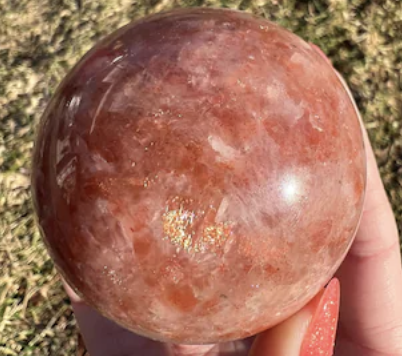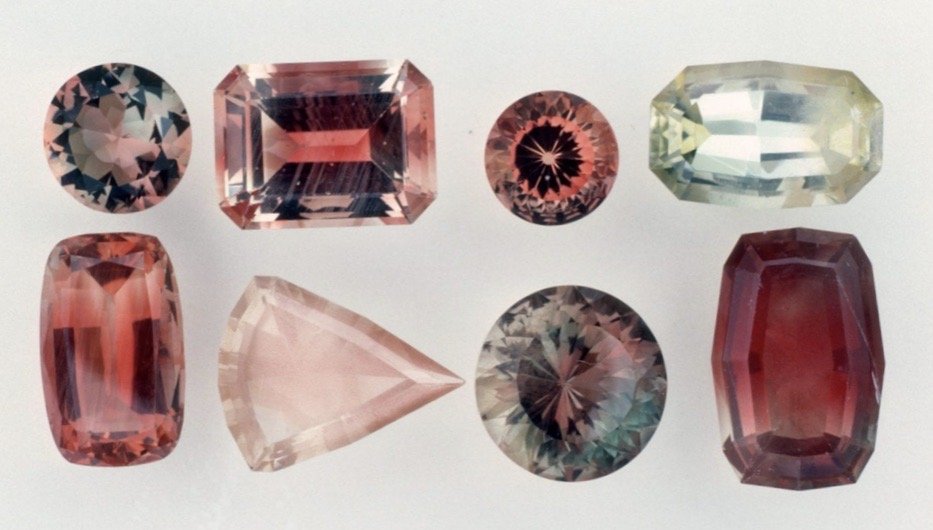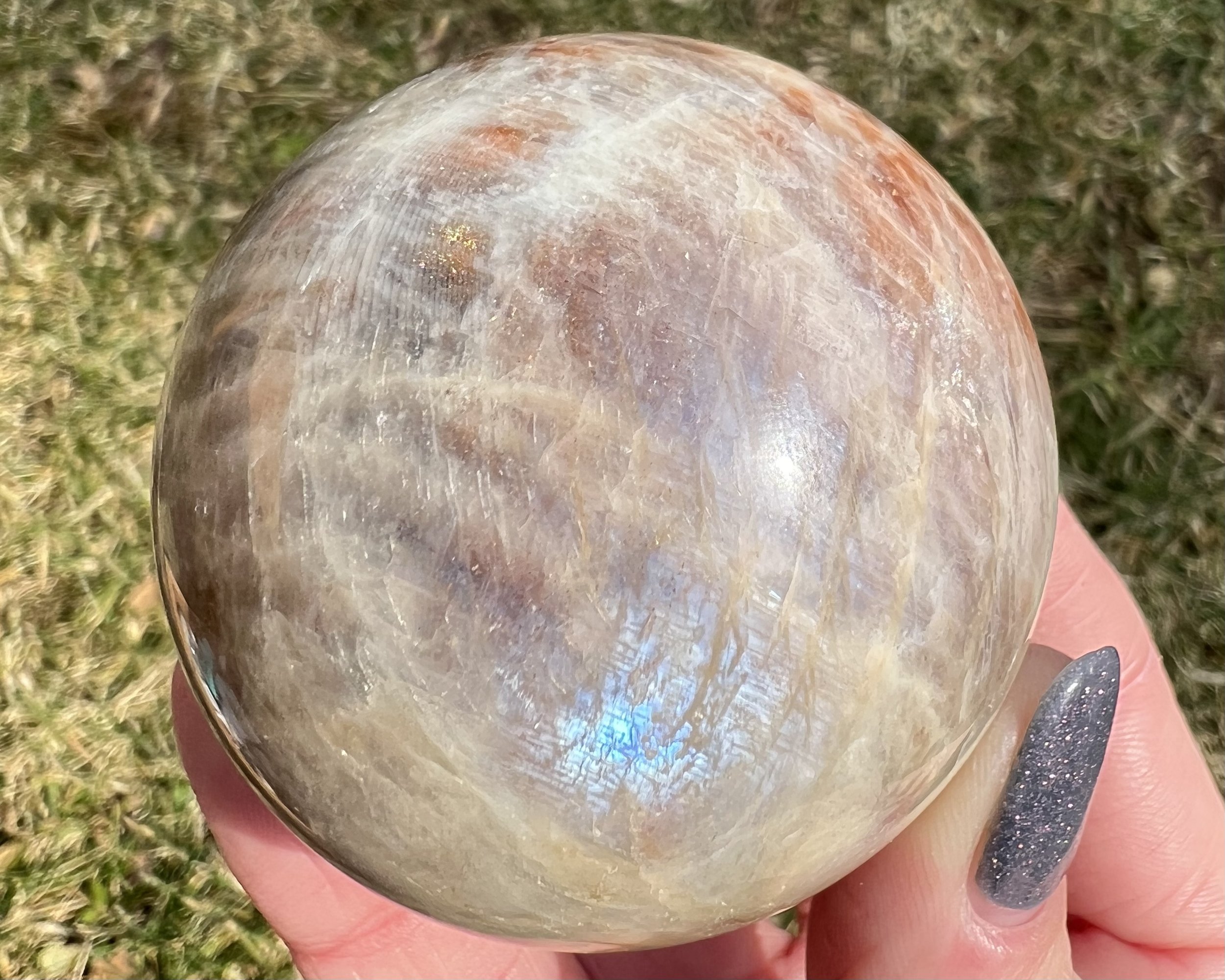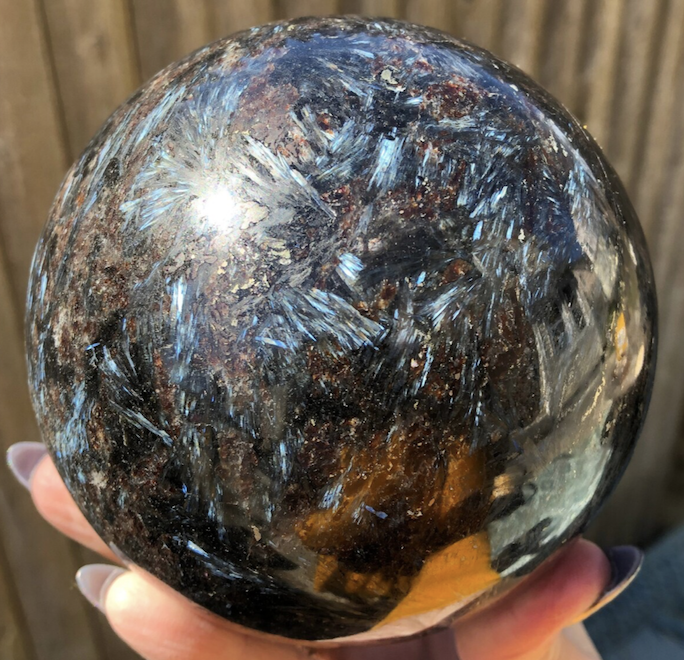
Sunstone and Sunstone and Sunstone
If you look up Sunstone in a google search, you will see many stones that vary wildly in appearance. That is because not all Sunstones are quite the same stone. There are three main types of Sunstones. One is usually mostly orange and more opaque and often has sparkly stuff in it. Another has more sparkles, more rainbows and less orange. The last is more transparent to translucent and may even change colors. They are all feldspars, and have inclusions that cause Aventurescence (also known as schiller) which is "sparkly, metallic-looking luster caused by flat, reflective inclusions" according to GIA. Their mineralogical name is Aventurine Feldspar. Beyond that, these stones have lots of differences.
The Sunstone most commonly seen by the average crystal enthusiast is probably the bright sparkly varieties of the Oligoclase and Orthoclase Feldspar groups. One Oligoclase Feldspar type of Sunstone you've probably seen is from India, cut and polished into spheres and hearts and palm stones. They have bright orange color with shiny Hematite platelets in a variety of colors that give it the trade name "Confetti Sunstone." There are similar varieties of this Sunstone from around the world including Tanzania and Canada.
In Australia, there is a type of Orthoclase Sunstone with long shiny plates of Hematite and Magnetite with rainbow iridescence that can intersect, lovingly called "Rainbow Lattice Sunstone." In these Sunstones the inclusions are hosted in a more translucent or even transparent Orthoclase that shows off the beautiful inclusions in them. In the bottom of this image is another example of an Orthoclase Sunstone- this one from Russia, where the plates are short and hexagonal but also very colorful.
The third type of Sunstone is most famously called Oregon Sunstone. It is the official state gemstone of Oregon. It is technically a type of Labradorite which has Copper inclusions (rather than Hematite ones) that cause its aventurescence. The first recorded occurrence of these stones was by Native Americans who used them in trade and sometimes buried them with their dead. Some Oregon Sunstones have pleochroism, or change colors at different angles. They occur in a range of colors including orange, red, yellow, green and blue.
These Sunstones are the only kind that are faceted often. In the late 1800s Tiffany & Co owned the first commercial mine for Oregon Sunstones which they marketed as "Plush Diamonds" but it didn't catch on as well as they'd hoped and at some point later on they sold the claims. Sunstones are not as popular as other stones in jewelry, but their natural beauty tends to capture the hearts of those who see them up close and in person.
There are mentions of a "sunstone" used by Vikings to navigate the seas in cloudy weather before the invention of the magnetic compass. This "sunstone" however was not Sunstone. We don't know for sure what stone they were using, but a shipwreck from the English Channel that sank in the 1500s had a crystal among its navigation tools, a piece of Optical Calcite- also called Iceland Spar- which is known for its diffraction of light. Many believe that it was pleochroic Iolite, which changes color depending on the angle of light as shown here. Both could be used to determine the position of the sun.
I hope you enjoyed my explanation of Sunstones! You can find several kinds of Sunstones including Rainbow Confetti Sunstones and even Moonstone & Sunstone together, in my Etsy shop. Thanks for reading! -Shawna
Arfvedsonite or Astrophyllite? Neither!
I’ve seen this same stone popping up at trade shows and supplier warehouses for years now, with several different names. Many suppliers call it “Fireworks Stone,” I see lots of it online sold as “Astrophyllite” or “Arfvedsonite.” I’ve seen lots of metaphysical sites comparing the two and proclaiming them to be one or the other. I have spent a long time trying to figure it out and in the past have settled for calling it Arfvedsonite just because I have to call it something. But there are many inconsistencies with those labels when it comes to the stone in question.
First the easiest one - “Fireworks Stone” is not a name of any mineral accepted by any reputable mineral or gem organization. It doesn’t mean anything and doesn’t tell us anything about what it actually is or the minerals in it. We call this a marketing or trade name - someone made it up to sell more rocks because it sounded cool or they didn’t actually know what kind of stone it was- or both.
Next, Astrophyllite. It forms gold, iridescent sprays much like the ones seen in the material in question. However, according to Mindat its color is “bronze-yellow, golden yellow, brown to reddish brown.” The stones that I have seen of the mystery material often have more blue than gold and yellow. Sometimes they are more gold too, but it cannot be Astrophyllite when so much of this material is so very blue. Astrophyllite also occurs more in radial “sun” shapes which often form full circles. Our mystery stone forms more often in “brush” shapes like a paintbrush pressed against a surface.
The third contender is Arfvedsonite. This is what I most commonly see this stone called online. If you post it in a mineral ID group, there will always be someone (never one of the geologists or mineralogists) who jumps to argue that it is Arfvedsonite. Mindat says the color of Arfvedsonite is “bluish-black to black” and in their gallery of 225 photos of Arfvedsonite specimens, all of them look closer to a Black Tourmaline than the material we are trying to identify. Every photo from a reputable source appears much like this photo - very dark or black crystals. Nothing iridescent gold or blue at all.
Finally after many hours spread over several years down this rabbit hole I believe I have found the answer. The name of the mineral in question is Anthophyllite. Anthophyllite is a fibrous amphibole mineral. It is also iridescent but can have gold, yellow, green, blue, and brown - so the iridescence of Anthophyllite fits much better than either of the other minerals it is often called.
On Mindat, there is a photo in the gallery for Anthophyllite that very much resembles the mystery material. It is labeled “Anthophyllite, Garnet, Cordierite.” The piece that I currently have does appear to have a lot of sparkly Almandine Garnet, which makes it a much more believable identification than other minerals. I have often seen the red part of this material called Eudialyte, but none of the aforementioned minerals appear to occur much in association with Eudialyte. My guess is that someone assumed it to be Eudialyte because that is a red mineral associated with Astrophyllite. Anthophyllite, on the other hand has both Garnet and Cordierite listed under common associates.
Another mineral listed under Anthophyllite’s common associates is Gedrite. This is interesting because Gedrite looks pretty similar to Anthophyllite, occurring in fibrous sprays, but is mostly black or dark green. The photo on the left here is Gedrite with Garnet. In the material I have now, shown on the right, there is a lot of shiny black sprays that are around the golden ones, and Anthophyllite and Gedrite do indeed occur together. Random fun fact- Gedrite and Anthophyllite alone together have a trade name you’ve probably heard before - Nuummite!
I found an article on Epigem that talks about this stone pictured, found in Sweden and described as an Anthophyllite schist “with reddish brown garnet, granular epidote and colorless cordierite.” This makes so much sense because so many of the pieces of this material I’ve had also had bits of green in them, and the one I’m looking at now does have some areas of clear stone that appears to sparkle similar to other cordierites I have had. In comparison, Cordierite does not often occur with Arfvedsonite, which mostly forms on Feldspars. It is also not listed as an associated mineral of Astrophyllite. So again, it seems that Anthophyllite is the most likely identification of these no-longer mysterious iridescent blue and gold sprays.
Andara Crystals: Trash or Treasure?
Maybe you’ve heard of Andara Crystals before. They’ve become popular in the metaphysical realm of crystals the last few years. According to one popular seller they are natural glass which “come from one of the Earth’s high-energy vortex sites in the High Sierra Nevadas of northern California, Lady Nellies Land.” There are a vast range of claims about Andara glass and the amazing things they can do.
One is that it contains something called “entherium,” containing 70 different minerals. This is complete nonsense. Entherium is completely made up and these pieces of glass do not have 70 minerals in them.
They also claim to be Monatomic - which means of one atom. Doesn’t make any sense in this s scenario.
I have read claims that Andara glass can aid in time and space travel, raise our vibrations, detox negativity, heal you, cleanse the chakras and it seems that there’s nothing these people WON’T say it can do! And they have price tags to match, with small pieces going for hundreds or thousands of dollars.
Sorry folks but Andara glass, regardless of what the seller says, is slag glass. It is the garbage found at an old abandoned dumping ground of a glass factory. Several “healers” buy the slag glass and distribute it to each other, making up names and creating “certifications” for each other. It’s ALL a scam. People are paying thousands of dollars for beautiful, lovely garbage. And hey- they are pretty! But you can buy the same exact thing for almost nothing from honest slag glass sellers.
There is a thread about the Andara scam on Mindat (one of the most reputable sites and forums for those who are truly interested in learning about minerals - frequented by many true experts of mineralogy and geology!) and one entry is a woman that says she is the only one who has a certain color of the glass, called “King Solomon,” and found out one of her buyers was reselling her glass as Andara glass. The woman expressed that she was very angry that her material was being used to scam others. In the thread, they even name some of the people responsible for the whole scam.
It just so happens that ‘new’ color variations of Andara glass happen to be ‘found’ at the same times that glass companies start dumping those same new colors. Huh. I can see how one could easily believe in the story of Andara glass, because Obsidian exists, but with a bit of research the evidence stacks up ridiculously tall against it being anything but an elaborate scam. I hope that this can save someone from wasting a lot of their hard earned money on a piece of slag glass they could get elsewhere for a few bucks.
What other fakes, frauds or scams have you heard of??
Please comment below!
-Shawna
Everyday Crystals
Crystals are pretty pieces of nature that we keep around because they're beautiful or make us feel happy. But crystals are also used in a lot of other important ways that most of us don't even think about.
Sugar is a very common type of crystal that we all know- Americans consume an average of 20 teaspoons a day!
Another crystal we love to eat? Salt-or sodium chloride- occurs naturally when saltwater evaporates, leaving cubic salt crystals.
Quartz is used in watches and clocks to keep accurate time, by sending electricity through a Quartz crystal. The electricity makes it vibrate at a precise frequency which regulates the movement of the clock or watch!
Graphite is a crystalline form of carbon that is very soft and has many uses. It is mixed with clay to create the 'lead' of pencils, which actually have no lead at all. Graphite is also used as a lubricant, conductor and plays an important role in Lithium batteries.
Silicon is an important ingredient to making computer chips and processors, so you can thank crystals for your smartphone and your laptop. LCD screens are Liquid Crystal Display. The liquid crystals are great at carrying light precisely so they make great screens.
Drywall is often made of gypsum, so you are likely surrounded by it right now if you're inside.
And if not, maybe you're surrounded by another type of crystal- snow- which is crystallized water.
These are just a few examples of crystals that we use or see in everyday life- besides the ones we keep for their beauty or metaphysical properties. Crystals are everywhere!
Enhydros
Sometimes a Quartz crystal will have a little pocket inside it, with liquid that moves around. You rock it side to side to watch the bubble move up and down and it is usually mesmerizing. These are often called enhydros. I call them that. Funny thing is- that’s NOT an enhydro! These are actually called fluid inclusions! An enhydro is something else altogether and I’ll get to that soon - I promise!
First, how do these liquid inclusions occur? When the Quartz crystal is forming, often from hot groundwater containing silica, there can be inconsistencies in the layers, where some parts form more quickly than others. In some cases this could cause a small pit to form. This pit, while full of water, is then sealed off when the Quartz continues to form over the pit. This leaves a pocket that is completely full of water.
Next, as the crystal cools, so too does the liquid inside- and both contract (become smaller in volume). The water contracts more than the crystal does, so that the liquid inside the pocket becomes smaller than the pocket itself. The liquid pulls away from the walls of its pocket, forming a little vapor bubble that can move around the pocket.
Vapor bubble formed inside Quartz
Milky Quartz gets it’s white color from tons of microscopic fluid inclusions. How crazy is that?! And the liquid trapped inside a crystal isn’t always just water. When hot saltwater gets trapped inside of Quartz, the salt can crystallize into a tiny Halite crystal! Herkimer diamonds from New York often have fluid inclusions with Carbon in them, which look like black specks. Some Quartz from Pakistan have Petroleum inside them, as well as Fluorites from Elmwood, Tennessee. Liquid inclusions vary so much- and they are tiny time capsules to geologists- a pure sample of the liquids present when the crystal formed!
So what is an enhydro?
An enhydro is defined as “a hollow nodule or geode of chalcedony containing water, sometimes in large amounts.”
Therefore, liquid inside Quartz it is not a true enhydro. Chalcedony is a micro-crystalline variety of Quartz (made up of many microscopic, elongated Quartz crystals), but Quartz is not a Chalcedony. Some varieties of Chalcedony include all Agates, Onyx, and Jaspers. So since Agate is a Chalcedony, that means that Agate geodes that have water trapped in the hollow center ARE in fact, true enhydros. They are probably the only liquid inclusion I know of that do fit the true definition of an enhydro!
Another difference between the two, is that with a liquid inclusion, we talked about how the liquid is forever trapped, and unless opened up that liquid will stay the same as it was the day it was trapped, for all eternity. But in an enhydro, the stone is porous, and the water actually is able to seep in and out of the geode! So the water inside could be from the time just before it was collected, rather than the time the stone itself formed. Once collected, the water can continue to seep out, though very slowly. Some seal them to keep this from happening.
Agate Enhydro Geodes
Now, I know that most folks already call liquid inclusions enhydros regardless of what type of rock they’re in, and that most people don’t know the difference. I’ll have to keep calling them enhydros so that people know what I’m talking about and can find them in my shop. But it’s still a fun bit of knowledge for you to have up there in your noggin!






































